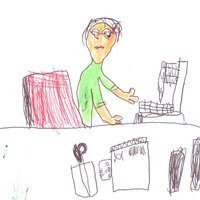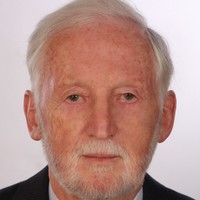Papers by Jakob Halfmann
Presentation (October 5, 2023) at the International Scientific Symposium
“Takht-i Sangin as an E... more Presentation (October 5, 2023) at the International Scientific Symposium
“Takht-i Sangin as an Example of the Synthesis of the Civilizations Of East And West”
dedicated to the 2500th anniversary of the site of Takht-i Sangin, Dushanbe, October 4-6, 2023.

Transactions of the Philological Society, 2023
Several dozen inscriptions in an unknown writing system have been discovered in an area stretchin... more Several dozen inscriptions in an unknown writing system have been discovered in an area stretching geographically from Kazakhstan, Uzbekistan and Tajikistan to southern Afghanistan. Most inscriptions can be dated to the period from the 2nd century BCE to the 3rd century CE, yet all attempts at decipherment have so far been unsuccessful. The recent discovery of previously unknown inscriptions near the Almosi gorge, Tajikistan, however, allows for a renewed attempt at decipherment. Drawing upon a catalogue of characters and a distributional analysis, we report two identical sequences in the newly found Almosi inscriptions and in the Da st-i N awur trilingual. Based on parallel texts in Bactrian, we suggest to read the name of the Kushan emperor Vema Takhtu in these sequences, accompanied by the title 'king of kings' and several epithets. This allows for the deduction of probable phonetic values of 15 different consonantal signs and four vocalic diacritics and the inference that the inscriptions record a previously unknown Middle Iranian language. ФИШУРДА Дар минтақае, ки аз Қазоқистону Ӯзбекистон ва Тоҷикистон то ҷануби Афғонистон тӯл мекашад, даҳҳо навиштаҷот бо як навъ хатти номаълум кашф карда шудаанд. Аксари ин катибаҳо мансуб ба асри II пеш аз милод то асри III мелодӣ мебошанд, аммо ҳама кӯшишҳои рамзкушоии он то ба ҳол бебарор буданд. Бо вуҷуди ин, кашфи катибаҳои нав бо хатти қаблан номаълум дар дараи Алмосии Тоҷикистон, имкон фароҳам овард, ки кӯшиши дубораи рамзкушоӣ анҷом дода шавад. Бо такя ба феҳристи аломатҳо ва таҳлили муқоисавӣ, мо аз ду пайдарпайии якхела дар катибаи тозакашфи Алмосӣ ва *The results of this article have first been presented at the digital conference "Discovery of the Almosi inscriptions and its significance in the system of ancient writings of Central Asia" (National Academy of Sciences of the Republic of Tajikistan) in Dushanbe, Tajikistan, on the 1st of March 2023. First, we thank Tim Williams who helped the German side of our team establish contact with Bobomullo Bobomulloev. After unsuccessful attempts to contact the Ecole franc ßaise d'Extrême-Orient, Agnes Korn and Philip Huyse helped us tremendously in finding out where the original photographs of Da st-i N awur are being held. We are indebted to the Coll ege de France and Claire Guttinger for sending us all available photographs and allowing us to use them in a publication, likewise to Ingo Strauch with regard to the Socotra inscription. We further thank the participants of the conference in Tajikistan for their feedback, questions and remarks. We especially thank Pavel Lurje, Lauren Morris, Joe Cribb and Ching Chao-jung for the discussions that followed this conference and for graciously sharing literature and photos that were not available to us before and Sviatoslav Kaverin for helping us access literature. Special thanks go to Simon Fries for comments that helped shape the text to its final form. We thank our colleagues and particularly Eugen Hill for supporting us with enthusiasm and questions, especially at the discussion that took place at the University of Cologne on the 12th of May 2023. Finally, we would also like to thank two anonymous reviewers for their comments and Lutz Marten for his great editorial support.

STUF - Language Typology and Universals
This article explores a typologically unusual but recurrent evolutionary path of innovated future... more This article explores a typologically unusual but recurrent evolutionary path of innovated future formations neglected by typological research: the change of predicative deverbal nouns (understood here in the broad sense of any deverbal nominal expression/formation) – namely agent nouns and participles – denoting actions typical of referents to future verb-forms via hypoanalysis. Starting with an overview of typologically recurrent ways of creating new future formations, the article seeks to demonstrate that the l-future found in the three Nuristani languages Nuristani Kalasha, Ashkun and Katë developed from active participles designating actions typical of their referents. As a typological parallel of this development the Vedic Sanskrit tā́-future is established, and it is shown by the example of the English will + infinitive future and the futurate use of Russian perfective non-past verb-forms how the change of predicative deverbal nouns denoting actions typical of referents to fu...
International Journal of Diachronic Linguistics and Linguistic Reconstruction, 2022
This article illustrates the potential of historical phonology to generate insights for various o... more This article illustrates the potential of historical phonology to generate insights for various other fields of research concerned with Nuristani languages. Three examples are discussed: The names of pre-Islamic deities, the areal spread of retroflex affricates and the unclear classification of Dameli.

Himalayan Linguistics, 2021
Recent years have seen an increase in the variety of language names used in linguistic works for ... more Recent years have seen an increase in the variety of language names used in linguistic works for the Nuristani languages (Indo-Iranian), which are spoken in Eastern Afghanistan and to some extent across the border in Northern Pakistan. This increase is driven by efforts to recognize local practices, but it has also created confusion and inconsistencies in many areas, making terminological justifications a necessary part of every publication regarding these languages. A unified terminology would not only be convenient for linguists and other researchers, in so far as scientific usage can influence colloquial practices it would also increase the visibility and recognizability of the languages of this little-known language family on the national and international level, thus also potentially benefiting the native speaking communities. The proposals given in this paper aim to create an internally consistent terminology that is scientifically precise, accurate, and recognizable for speakers, while also being congruent with the naming principles put forward for the Glottolog database.
Conference Presentations by Jakob Halfmann
Presentation (October 5, 2023) at the International Scientific Symposium “Takht-i Sangin as an Ex... more Presentation (October 5, 2023) at the International Scientific Symposium “Takht-i Sangin as an Example of the Synthesis of the Civilizations Of East And West” dedicated to the 2500th anniversary of the site of Takht-i Sangin, Dushanbe, October 4-6, 2023.
Presentation at the International Scientific Work Seminar of the Academy of Sciences of Tajikista... more Presentation at the International Scientific Work Seminar of the Academy of Sciences of Tajikistan on the topic "Discovery of the Almosi Inscriptions and Their Position among the Ancient Scripts of Central Asia", 1 March, 2023.











Uploads
Papers by Jakob Halfmann
“Takht-i Sangin as an Example of the Synthesis of the Civilizations Of East And West”
dedicated to the 2500th anniversary of the site of Takht-i Sangin, Dushanbe, October 4-6, 2023.
Conference Presentations by Jakob Halfmann
“Takht-i Sangin as an Example of the Synthesis of the Civilizations Of East And West”
dedicated to the 2500th anniversary of the site of Takht-i Sangin, Dushanbe, October 4-6, 2023.